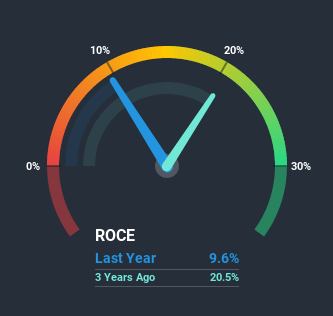- South Korea
- /
- Consumer Services
- /
- KOSDAQ:A067280
We're Watching These Trends At Multicampus (KOSDAQ:067280)
If you're not sure where to start when looking for the next multi-bagger, there are a few key trends you should keep an eye out for. One common approach is to try and find a company with returns on capital employed (ROCE) that are increasing, in conjunction with a growing amount of capital employed. If you see this, it typically means it's a company with a great business model and plenty of profitable reinvestment opportunities. However, after investigating Multicampus (KOSDAQ:067280), we don't think it's current trends fit the mold of a multi-bagger.
Return On Capital Employed (ROCE): What is it?
For those who don't know, ROCE is a measure of a company's yearly pre-tax profit (its return), relative to the capital employed in the business. To calculate this metric for Multicampus, this is the formula:
Return on Capital Employed = Earnings Before Interest and Tax (EBIT) ÷ (Total Assets - Current Liabilities)
0.096 = ₩14b ÷ (₩193b - ₩49b) (Based on the trailing twelve months to September 2020).
Therefore, Multicampus has an ROCE of 9.6%. Even though it's in line with the industry average of 9.8%, it's still a low return by itself.
See our latest analysis for Multicampus

Historical performance is a great place to start when researching a stock so above you can see the gauge for Multicampus' ROCE against it's prior returns. If you want to delve into the historical earnings, revenue and cash flow of Multicampus, check out these free graphs here.
How Are Returns Trending?
Over the past five years, Multicampus' ROCE and capital employed have both remained mostly flat. Businesses with these traits tend to be mature and steady operations because they're past the growth phase. With that in mind, unless investment picks up again in the future, we wouldn't expect Multicampus to be a multi-bagger going forward.
On another note, while the change in ROCE trend might not scream for attention, it's interesting that the current liabilities have actually gone up over the last five years. This is intriguing because if current liabilities hadn't increased to 25% of total assets, this reported ROCE would probably be less than9.6% because total capital employed would be higher.The 9.6% ROCE could be even lower if current liabilities weren't 25% of total assets, because the the formula would show a larger base of total capital employed. So while current liabilities isn't high right now, keep an eye out in case it increases further, because this can introduce some elements of risk.The Bottom Line On Multicampus' ROCE
In a nutshell, Multicampus has been trudging along with the same returns from the same amount of capital over the last five years. Since the stock has declined 31% over the last five years, investors may not be too optimistic on this trend improving either. On the whole, we aren't too inspired by the underlying trends and we think there may be better chances of finding a multi-bagger elsewhere.
One more thing to note, we've identified 1 warning sign with Multicampus and understanding this should be part of your investment process.
While Multicampus isn't earning the highest return, check out this free list of companies that are earning high returns on equity with solid balance sheets.
If you’re looking to trade Multicampus, open an account with the lowest-cost* platform trusted by professionals, Interactive Brokers. Their clients from over 200 countries and territories trade stocks, options, futures, forex, bonds and funds worldwide from a single integrated account. Promoted
New: Manage All Your Stock Portfolios in One Place
We've created the ultimate portfolio companion for stock investors, and it's free.
• Connect an unlimited number of Portfolios and see your total in one currency
• Be alerted to new Warning Signs or Risks via email or mobile
• Track the Fair Value of your stocks
This article by Simply Wall St is general in nature. It does not constitute a recommendation to buy or sell any stock, and does not take account of your objectives, or your financial situation. We aim to bring you long-term focused analysis driven by fundamental data. Note that our analysis may not factor in the latest price-sensitive company announcements or qualitative material. Simply Wall St has no position in any stocks mentioned.
*Interactive Brokers Rated Lowest Cost Broker by StockBrokers.com Annual Online Review 2020
Have feedback on this article? Concerned about the content? Get in touch with us directly. Alternatively, email editorial-team@simplywallst.com.
About KOSDAQ:A067280
Multicampus
Operates in the education activities for the HRD system primarily in South Korea.
Flawless balance sheet, good value and pays a dividend.
Market Insights
Community Narratives



